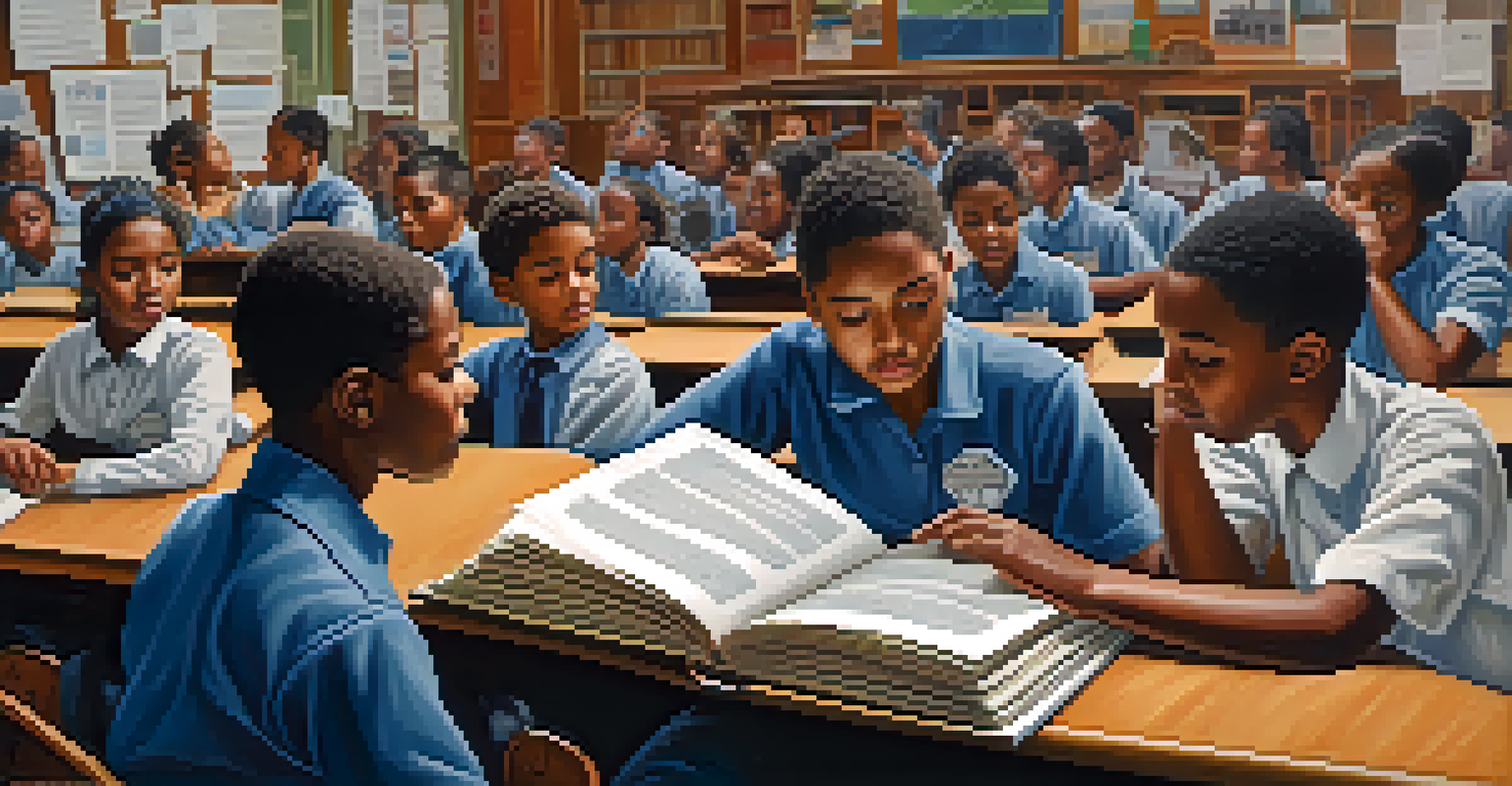Using Historical Fiction to Teach Core Historical Concepts

The Power of Storytelling in Historical Education
Storytelling has been a fundamental way humans share knowledge for centuries. When it comes to teaching history, stories help to humanize events and figures, making them more relatable. Historical fiction immerses readers in a time period, allowing them to experience the emotions and conflicts that shaped history.
Stories can conquer fear, you know. They can make you feel less alone.
For instance, novels set during World War II can provide insight into the lives of ordinary people affected by the war. By focusing on personal narratives, students can grasp the complexities of historical events beyond dry facts and dates. This emotional connection fosters a deeper understanding of the past.
Moreover, stories often highlight diverse perspectives, encouraging empathy and critical thinking. When students engage with characters from different backgrounds, they can better appreciate the multifaceted nature of history, which is essential for a well-rounded education.
Creating Context Through Fictional Narratives
Historical fiction serves as a bridge to understanding broader historical contexts. By placing characters in significant events, authors can illustrate the causes and consequences of those events in a compelling way. This contextualization helps students see the 'big picture' of history.

Take, for example, a novel set during the Civil Rights Movement. Readers can learn about the challenges faced by activists through the eyes of a fictional character, experiencing their struggles and triumphs in a visceral manner. This approach not only teaches facts but also evokes a sense of place and time.
Storytelling Humanizes History
Historical fiction makes historical events relatable by focusing on personal narratives that evoke emotional connections.
As students engage with these narratives, they begin to form connections and ask questions about the societal dynamics of that era. This critical inquiry is essential for developing a comprehensive understanding of history, beyond mere memorization.
Engaging Reluctant Learners with Fiction
Not every student is excited about learning history, and this is where historical fiction can shine. For reluctant learners, a gripping storyline can ignite interest in historical topics that may seem dull at first. When students are invested in a character's journey, they are more likely to engage with the accompanying historical content.
History is a vast early warning system.
For instance, a young adult novel about a teenager during the Great Depression may resonate with students who find difficulty connecting with traditional textbooks. The relatable struggles and triumphs depicted can spark curiosity about the actual historical events and encourage further exploration.
By blending entertainment with education, historical fiction can transform how students perceive history. This newfound interest can lead to a deeper commitment to learning and an appreciation for the complexities of the past.
Fostering Critical Thinking Through Historical Analysis
Historical fiction encourages students to think critically about the narratives they read. As they analyze the motivations of characters or the accuracy of events, they learn to question and evaluate sources. This analytical skill is crucial for understanding history's nuances and the often subjective nature of storytelling.
For example, students might compare a historical novel's portrayal of events with actual historical documents. This exercise not only sharpens their critical thinking but also teaches them the importance of analyzing multiple viewpoints. They learn that history is not a single, unchanging narrative but a tapestry woven from diverse experiences.
Empathy Through Diverse Perspectives
Engaging with characters from various backgrounds fosters empathy and critical thinking, enriching students' understanding of history.
Encouraging students to engage with conflicting interpretations fosters a mindset of inquiry. This practice prepares them for real-world situations where they must discern fact from opinion and understand various contexts.
Promoting Empathy Through Character Perspectives
One of the most impactful benefits of historical fiction is its ability to cultivate empathy in readers. By stepping into the shoes of characters from different backgrounds and eras, students gain insight into experiences vastly different from their own. This emotional exercise is vital for understanding the human experience throughout history.
Consider a novel featuring a Jewish family's struggles during the Holocaust. Readers can feel the fear, resilience, and hope of the characters, which humanizes the historical events. Such emotional connections can lead to a greater understanding of the consequences of prejudice and discrimination.
Empathy is a powerful tool in education, promoting kindness and understanding in our increasingly diverse world. By recognizing the human stories behind historical events, students are more likely to develop compassion and respect for others.
Integrating Historical Fiction into Curriculum
Incorporating historical fiction into classroom discussions can enhance the overall learning experience. Teachers can select novels that align with their curriculum, allowing students to explore historical themes in a relatable way. This integration can lead to more dynamic discussions and a richer understanding of core concepts.
For example, pairing a historical novel with a lesson on the Industrial Revolution can help students visualize the societal changes that occurred during that time. Teachers can facilitate discussions that connect the novel's events with the broader historical context, encouraging students to make connections.
Inspiring Lifelong Interest in History
Exposure to captivating historical narratives can spark a passion for history that encourages students to continue exploring beyond the classroom.
Moreover, students can be tasked with creative projects, such as writing their own historical narratives. This hands-on approach fosters engagement and reinforces their understanding of historical concepts while allowing for personal expression.
Encouraging Lifelong Learning Through Historical Fiction
Exposure to historical fiction can ignite a passion for history that extends beyond the classroom. When students discover the captivating storytelling found in historical novels, they may be inspired to seek out more books or resources on their own. This can lead to a lifelong interest in learning about the past.
For instance, a student who becomes enamored with a novel about ancient civilizations might pursue further reading or even studies in archaeology or history. This enthusiasm not only enhances their education but also contributes to their personal growth and development.

By fostering a love for history through engaging narratives, educators can help create informed citizens who appreciate the complexities of the past. This appreciation is essential for understanding the present and shaping a better future.